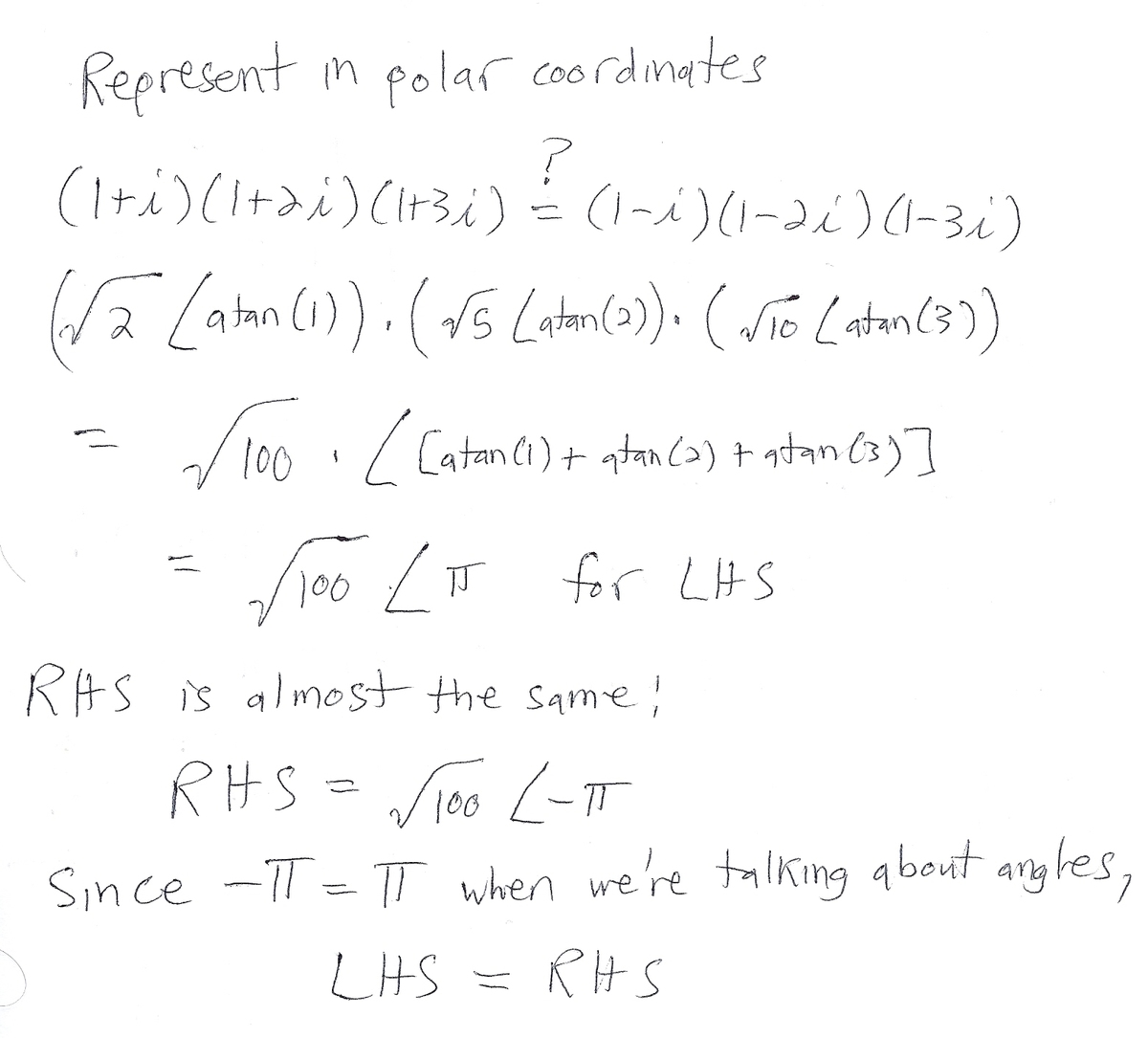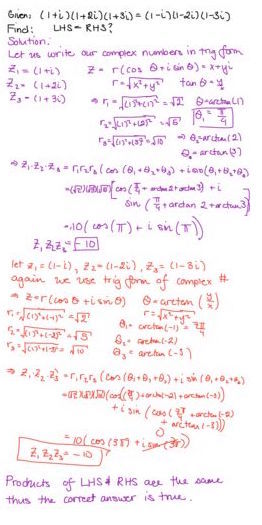Avoid Doing Complex Arithmetic
True or False?
( 1 + i ) ( 1 + 2 i ) ( 1 + 3 i ) = ( 1 − i ) ( 1 − 2 i ) ( 1 − 3 i )
Clarification : i = − 1 .
Bonus : Prove it without expanding all the terms.
This section requires Javascript.
You are seeing this because something didn't load right. We suggest you, (a) try
refreshing the page, (b) enabling javascript if it is disabled on your browser and,
finally, (c)
loading the
non-javascript version of this page
. We're sorry about the hassle.
7 solutions

Moderator note:
Great! When multiplying complex numbers, it is often easier to evaluate them in the RCiS form, and perform those calculations separately. In this case, because ( r , π ) and ( r , − π ) yield the same point on the complex plane, the (surprising) result follows.
What is 'atan' in your answer?
This is sort of multiplying things out, but I did not multiply everything out.
( 1 + i ) ( 1 + 2 i ) = 3 i − 1
( 1 − i ) ( 1 − 2 i ) = − 3 i − 1 = − ( 3 i + 1 )
For the LHS, we have ( 3 i − 1 ) ( 3 i + 1 )
For the RHS, we have − ( 3 i + 1 ) ( 1 − 3 i ) which is the same as ( 3 i − 1 ) ( 3 i + 1 )
Thus, LHS = RHS and I didn't multiply everything out.
Tan(x+y+z)=(tanx+tany+tanz-tanx.tany.tanz)/(1-tanx.tany-tany.tanz-tanz.tanx)=0
X+y+z=kπ, with x,y,z<π/2 this means k=1
Complex numbers are rotations, All rotations in L are positieve, All rotations in R are negatieve and Both yield to a rotation over angle pi.
Also, if L=R, then LL=RR=100 and thus L=+/-R=+/-10.
With rotation over π, this leaves -10 as a sollution: L=R=-10.
This is a placeholder. If no one else has added a non brute force solution by Sept 1st, I will add mine.
Hint: What is tan − 1 1 + tan − 1 2 + tan − 1 3 ?

I'm not quite sure how to zoom it in to make the answer a bit more visible, but I hope you can see the solution. I used trig form of complex numbers to prove the equations true.
Open up interactive Python:
1 2 |
|
Proving the statement is equivalent to proving the equivalent form:
⇔ ⇔ ⇔ ( 1 − i ) ( 1 − 2 i ) ( 1 − 3 i ) ( 1 + i ) ( 1 + 2 i ) ( 1 + 3 i ) ( i i ⋅ 1 − i 1 + i ) ( i i ⋅ 1 − 2 i 1 + 2 i ) ( i i ⋅ 1 − 3 i 1 + 3 i ) i − i 2 i + i 2 ⋅ i − 2 i 2 i + 2 i 2 ⋅ i − 3 i 2 i + 3 i 2 ( i + 1 ) ( i + 2 ) ( i + 3 ) ( i − 1 ) ( i − 2 ) ( i − 3 ) = = = = 1 1 1 1
Let f ( x ) = ( x − 1 ) ( x − 2 ) ( x − 3 ) and g ( x ) = ( x + 1 ) ( x + 2 ) ( x + 3 ) . By Vieta's formula , we can quickly expand these polynomials to get
{ f ( x ) = x 3 − 6 x 2 + 1 1 x − 6 g ( x ) = x 3 + 6 x 2 + 1 1 x + 6 ⇒ { f ( i ) = i 3 − 6 i 2 + 1 1 i − 6 = 1 0 i g ( i ) = i 3 + 6 i 2 + 1 1 i + 6 = 1 0 i ⇒ ( i + 1 ) ( i + 2 ) ( i + 3 ) ( i − 1 ) ( i − 2 ) ( i − 3 ) = g ( i ) f ( i ) = 1 .
We're done!
That's more time consuming than performing the complex arithmetic. Note that you essentially did it in the end by expanding out f ( x ) , g ( x ) .
Log in to reply
Haha, I know. I just want to write a different (yet lousier) approach.